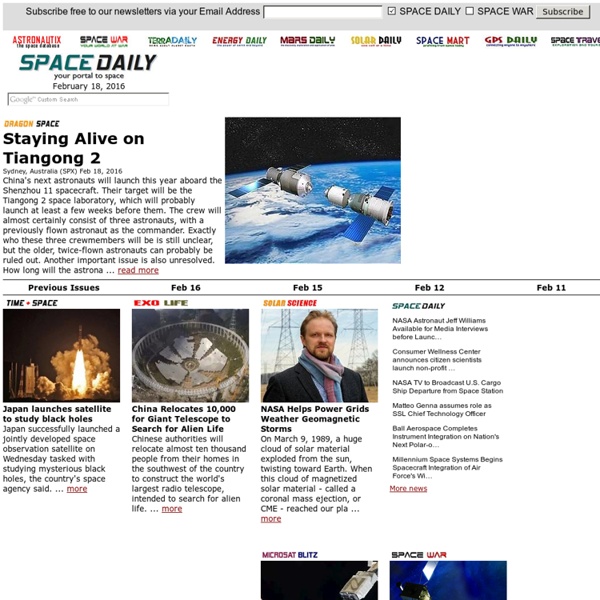Zoom
Trash
Related: space



SETI Institute Cincinnati Astronomical Society Helioseismology Helioseismology The science studying wave oscillations in the Sun is called helioseismology. One can view the physical processes involved, in the same way that seismologists learn about the Earth's interior by monitoring waves caused by earthquakes. Temperature, composition, and motions deep in the Sun influence the oscillation periods and yield insights into conditions in the solar interior. Waves The primary physics in both seismology and helioseismology are wave motions that are excited in the body's (Earth or Sun) interior and that propagate through a medium. However, there are many differences in number and type of waves for both terrestrial and solar environments.
Venus Transit Thursday, June 07, 2012 Contributed By: Craig Niemi | Cincinnati Astronomical Society Tuesday June 5th thousands of inquisitive stargazers around the Greater Cincinnati area witnessed, at least for a few minutes, the once-in-a-lifetime transit of Venus. A little after 6pm, the planet Venus started its trek across the face of the Sun. Depending on their location many folks got a peek at the beginning of the event and again just before sunset. Through partly cloudy skies they saw a small ink-black dot slowly creeping across a fiery ball. Don’t despair if you missed this one, you’ll get another chance December 2117. The Cincinnati Astronomical Society (CAS) partnered with the Fernald Preserve in Harrison and with the Drake Planetarium in Norwood to share the event with hundreds of adults and children. On Saturday June 30th you can continue your own exploration of the solar system with “Our Marvelous Moon” at the Cincinnati Astronomical Society headquarters on Zion Road.
Lunar Missions Ltd - Lunar Mission One Whether you are looking to be kept regularly updated on the progress of Lunar Mission One, or whether you want to influence the future of Lunar Mission One, the Lunar Missions Club is your key to being part of this historic mission. The Lunar Missions Club will be a community which, over the next ten years, will help guide this mission to success. Members of the Lunar Missions Club will be kept up to date with the latest mission developments, receiving exclusive newsletters and updates from the Lunar Mission One team. The club will be officially launched in 2015 but early-adopters can continue their discussions through our Kickstarter site until we launch the main club here.
Clear Sky Chart CAS DSS It's the astronomer's forecast. At a glance, it shows when it will be cloudy or clear for up to the next two days. It's a prediction of when Cincinnati Astronomical Society Dark Sky Site, OH, will have good weather for astronomical observing. The data comes from a forecast model developed by Allan Rahill of the Canadian Meteorological Center. So, I (Attilla Danko) wrote a script to generate the images like the one above which summarizes CMC's forecast images just for Cincinnati Astronomical Society Dark Sky Site and the surroundings out to about 10 miles. There are charts for 4704 locations. Summary: In the rows labeled "sky conditions", find a column of blue blocks. Details: Read the image from left to right. The line, labeled Cloud Cover forecasts total cloud cover. CMC's text page explaining this forecast is here. The line, labeled Transparency, forecasts the transparency of the air. The line, labeled Seeing, forecasts astronomical seeing. This forecasts ground-level relative humidity.
The Space Race By the mid-1950s, the U.S.-Soviet Cold War had worked its way into the fabric of everyday life in both countries, fueled by the arms race and the growing threat of nuclear weapons, wide-ranging espionage and counter-espionage between the two countries, war in Korea and a clash of words and ideas carried out in the media. These tensions would continue throughout the space race, exacerbated by such events as the construction of the Berlin Wall in 1961, the Cuban missile crisis of 1962 and the outbreak of war in Southeast Asia. Space exploration served as another dramatic arena for Cold War competition. On October 4, 1957, a Soviet R-7 intercontinental ballistic missile launched Sputnik (Russian for “traveler”), the world’s first artificial satellite and the first man-made object to be placed into the Earth’s orbit. Sputnik’s launch came as a surprise, and not a pleasant one, to most Americans.
Why are there dozens of dead animals floating in space? On July 20, 1969, Neil Armstrong became the first man in history to step on the surface of the moon. Millions of people tuned in to a broadcast of the event, and after Edwin "Buzz" Aldrin Jr. joined Armstrong, the two spent about two and a half hours gathering lunar rocks to bring back for analysis. The success was a triumph, not just for the United States, but for mankind, the imagination and the possibilities of exploration. What many people don't know, however, are the special sacrifices that had to be made in order to get astronauts up into space at all. The major unsung heroes of space exploration, it turns out, are animals. Before space programs started sending people up into orbit, scientists couldn't agree on what it would be like for a living organism to leave Earth's atmosphere. To learn more about animals in space and how they helped scientists learn more about space exploration, see the next page.
Solar System Visualization Project Solar System Visualization(SSV) ProjectScience Collaboration Testbed (SCT) Task Significant and Additional Content: Mars Science Update - Mars: An Active Planet Today? Malin Space Science Systems Super Resolution Mars Pathfinder Pan by Tim Parker MVACS Processing flow diagram by David A. (Click image to see the entire diagram) Mars Polar Lander Demo Page Prototype DemonstrationsThe links and images which follow are "story-board" mockups of proposed web pages, tools, and environments.